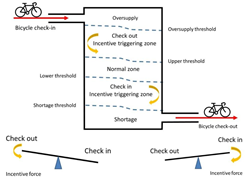Dockless Shared Bicycle Flow Control by Using Kernel Density Estimation Based Clustering
DOI:
https://doi.org/10.46604/aiti.2021.6666Keywords:
classification, clustering, unsupervised neural networks learning, R language, choropleth mapAbstract
Since dockless sharing bicycles have become an indispensable means of everyday life for urban residents, how to effectively control the supply and demand balance of bikes has become an important issue. This study aims to apply Kernel Density Estimation based (KDE-based) clustering analysis and a threshold-based reverse flow incentive mechanism to encourage the users of bicycles to adjust the supply and demand actively. And it takes Shanghai Jing’an Temple and its surroundings as the research area. Its practical steps include: (1) compilation and processing of the needed data, (2) application of KDE-based clustering, partitioning, and grading, and (3) incentives calculation based on dockless shared bicycle flow control system. The study finds that the generalization function of KDE-based clustering can be used to estimate the density value at any point in the study area to support the calculation of the incentive mechanism for bicycle reverse flow.
References
S. K. Chang, H. W. Chang, and Y. W. Chen, Green Transportation, Slow, Friendly, and Sustainable: People-Oriented Transportation Environment Makes The City Smoother and Life Better, Taipei: Neonaturalism, 2013. (In Chinese)
W. Zhu, J. Y. He, and D. Wang, “Methods and Empirical Research on the Distribution of Public Bicycle Systems in France: Case Study on Paris and Lyon,” Urban Planning International, vol. 30, no. S1, pp. 64-70, 2015.
Y. Li, Y. Zheng, H. Zhang, and L. Chen, “Traffic Prediction in a Bike-Sharing System,” Proceedings of the 23rd SIGSPATIAL International Conference on Advances in Geographic Information Systems, no. 33, November 2015, pp. 1-10.
J. Speck, Walkable City: How Downtown Can Save America, One Step at a Time, New York: North Point, November 2012.
N. Wang and Y. C. Du, “Resident Walking Distance Threshold of Community,” Transport Research, vol. 1, no. 2, pp. 20-24, June 2015. (In Chinese)
M. Negnevitsky, Artificial Intelligence: A Guide to Intelligent Systems, London: Pearson Education Limited, 2011.
J. C. Príncipe, N. R. Euliano, and W. C. Lefebvre, Neural and Adaptive Systems: Fundamentals through Simulations, New York: Wiley, 2000.
M. C. Su and X. D. Zhang, Machine Learning: Neural Networks, Fuzzy Systems, and Gene Algorithms, 2nd ed. Taipei: Chuan Hwa, 2004. (In Chinese)
A. D. Kulkarni, Computer Vision and Fuzzy-Neural System, New Jersey: Prentice Hall PTR, 2001.
C. C. Aggarwal and C. K. Reddy, Data Clustering: Algorithms and Applications, London: Chapman and Hall/CRC, 2013.
G. Gan, C. Ma, and J. Wu, Data Clustering: Theory, Algorithms, and Applications, USA: Society for Industrial and Applied Mathematics, 2007.
J. Han, M. Kamber, and J. Pei, Data Mining: Concepts and Techniques, 3rd ed. Massachusetts: Morgan Kaufmann, 2012.
S. K. Popat and M. Emmanuel, “Review and Comparative Study of Clustering Techniques,” International Journal of Computer Science and Information Technologies, vol. 5, no. 1, pp. 805-812, 2014.
A. Saxena, M. Prasad, A. Gupta, N. Bharill, O. P. Patel, A. Tiwari, et al., “A Review of Clustering Techniques and Developments,” Neurocomputing, vol. 267, pp. 664-681, December 2017.
P. N. Tan, M. Steinbach, and V. Kumar, Introduction to Data Mining, 1st ed. London: Pearson, pp. 491-493, 2005.
S. Theodoridis and K. Koutroumbas, Pattern Recognition, 4th ed. USA: Elsevier, December 2009.
H. Shah, K. Napanda, and L. D’mello, “Density-Based Clustering Algorithms,” International Journal of Computer Sciences and Engineering, vol. 3, pp. 54-57, 2015.
Z. Xie and J. Yan, “Detecting Traffic Accident Clusters with Network Kernel Density Estimation and Local Spatial Statistics: an Integrated Approach,” Journal of Transport Geography, vol. 31, pp. 64-71, July 2013.
T. K. Anderson, “Kernel Density Estimation and K-Means Clustering to Profile Road Accident Hotspots,” Accident Analysis & Prevention, vol. 41, no. 3, pp. 359-364, May 2009.
W. Yu and T. Ai, “The Visualization and Analysis of Urban Facility Pois using Network Kernel Density Estimation Constrained by Multi-Factors,” Boletim de Ciências Geodésicas, vol. 20, no. 4, pp. 902-926, October 2014.
M. C. Jones, “Variable Kernel Density Estimates, and Variable Kernel Density Estimates,” Australian Journal of Statistics, vol. 32, no. 3, pp. 361-371, 1990.
T. C. Bailey and A. C. Gatrell, Interactive Spatial Data Analysis, Harlow: Longman, 1995.
A. C. Gatrell, T. C. Bailey, P. J. Diggle, and B. S. Rowlingson, “Spatial Point Pattern Analysis and Its Application in Geographical Epidemiology,” Transactions of the Institute of British Geographers, vol. 21, no.1, pp. 256-274, 1996.
T. Hart and P. Zandbergen, “Kernel Density Estimation and Hotspot Mapping: Examining the Influence of Interpolation Method, Grid Cell Size, and Bandwidth on Crime Forecasting,” Policing: An International Journal of Police Strategies & Management, vol. 37, no. 2, pp. 305-323, May 2014.
G. O. Ricardo, “Kernel Density Estimation,” http://csyue.nccu.edu.tw/ch/Kernel%20Estimation(Ref).pdf, August 2019.
“Kernel (Statistics),” https://en.wikipedia.org/wiki/Kernel_(statistics), August 2019.
S. Y. Chen and T. T. Chen, “Application of Cluster Analysis with Unsupervised Learning to Dockless Shared Bicycle Flow Control and Dispatching,” Computer-Aided Design and Application, vol. 17, no.5, pp. 1067-1083, 2020.
“Soda Open Data,” http://shanghai.sodachallenges.com/data.html, August 2019. (In Chinese)
J. P. Lander, R for Everyone: Advanced Analytics and Graphics, Boston: Addison-Wesley Professional, December 2013.
Beijing Planning Design Research Institute, “2017 Sharing Bike, and Urban Development White Paper”, http://www.199it.com/archives/581592.html, 2017. (In Chinese)

Published
How to Cite
Issue
Section
License
Submission of a manuscript implies: that the work described has not been published before that it is not under consideration for publication elsewhere; that if and when the manuscript is accepted for publication. Authors can retain copyright in their articles with no restrictions. is accepted for publication. Authors can retain copyright of their article with no restrictions.
Since Jan. 01, 2019, AITI will publish new articles with Creative Commons Attribution Non-Commercial License, under The Creative Commons Attribution Non-Commercial 4.0 International (CC BY-NC 4.0) License.
The Creative Commons Attribution Non-Commercial (CC-BY-NC) License permits use, distribution and reproduction in any medium, provided the original work is properly cited and is not used for commercial purposes.







